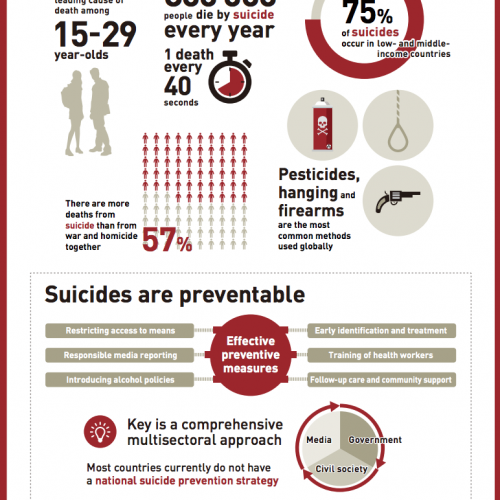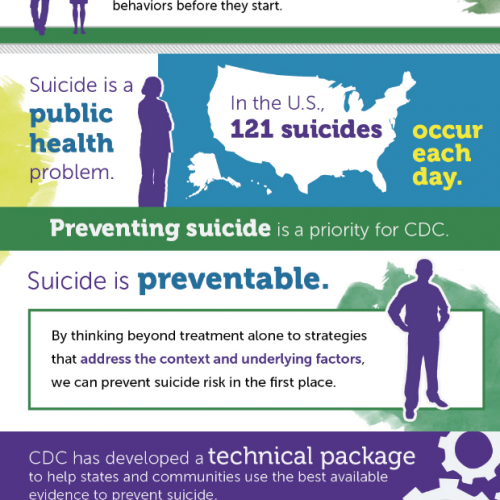
Suicide
Definition
The following definition is from the CDC:
- Suicide—Death caused by self-directed injurious behavior with an intent to die as a result of the behavior.
- Suicide Attempt—A non-fatal, self-directed, potentially injurious behavior with an intent to die as a result of the behavior; might not result in injury.
- Suicidal ideation—Thinking about, considering, or planning suicide.
Key concepts: suicide, suicide ideation, suicide prevention, effect on family and friends, co-occurring disorders, veterans, youth.
Suicide Prevention Day: September 10th, 2018
Seminal or Relevant Peer-reviewed Journal Articles
Reducing Suicide: A National Imperative
Goldsmith, S. K. (2002). Reducing suicide: a national imperative. Washington, D.C.: National Academies Press.
Provides a blueprint for addressing this tragic and costly problem: how we can build an appropriate infrastructure, conduct needed research, and improve our ability to recognize suicide risk and effectively intervene. This new volume will be of special interest to policy makers, administrators, researchers, practitioners, and journalists working in the field of mental health.
Alcohol and Suicidal Behavior
Hufford MR (2001). Alcohol and suicidal behavior. Clinical Psychology Review, 21, (5), 797-811.
This review presents a conceptual framework relating alcohol to suicidal behavior. Distal risk factors create a statistical potential for suicide. Alcohol dependence, as well as associated co-morbid psychopathology and negative life events, act as distal risk factors for suicidal behavior.
If Suicide is a public health problem, what are we doing to prevent it?
Knox KL, Conwell Y, Caine ED (2004). If suicide is a public health problem, what are we doing to prevent it? American Journal of Public Health, 94, 37–45.
Article describing the gap for suicide prevention research focusing on the need for community driven approaches to face this global public health problem
Suicidal Thoughts and Behavior among Adults: Results from the 2014 National Survey on Drug Use and Health
Lipari, R. Piscopo, K. RTI International: Kroutilm, Larry A and Greta Kilmer Miller Suicidal Thoughts and Behavior among Adults: Results from the 2014 National Survey on Drug Use and Health
SAMHSA uses information on suicidal thoughts and behavior among adults from the National Survey on Drug Use and Health (NSDUH) in efforts to prevent suicides and to provide services to people who are at risk.
Current Books
Night falls fast: understanding suicide
Night falls fast: understanding suicide
This is a book that helps us to understand the suicidal mind, to recognize and come to the aid of those at risk, and to comprehend the profound effects on those left behind. It is critical reading for parents, educators, and anyone wanting to understand this tragic epidemic

Current Top Websites
Statistics on suicide
The CDCs page on suicide including an overview, data, prevention strategies and other research.
SAMHSA’s page on suicide with lots of information on everything related to prevention, healing, causes, support etc of suicide.
A federally supported resource center devoted to advancing the National Strategy for Suicide Prevention. Has information on prevention, trainings, programs, and other things related to suicide.
A large resource list for Suicide prevention and survivors. Has useful information for many other countries as well including Canada, France, Italy, Brazil, and Argentina among others.

Webinars and Online Trainings
The Training Page for the Suicide Prevention Resource Center
A list of trainings, online courses, webinars and videos relating to Suicide prevention
CASAT Courses on Suicide in person and online
An in-person course on suicidal assessment and two online courses on suicidal thoughts available at CASAT.
Be the One To – 5 Steps anyone can use to help someone in crisis
5 Steps include—Ask, Keep them safe, Be there, Help them connect, and Follow up.
Tools Available Online
We can all help prevent suicide. The Lifeline provides 24/7, free and confidential support for people in distress, prevention and crisis resources for you or your loved ones, and best practices for professionals
Crisis Text Line is free, 24/7 support for those in crisis. Text 741741 from anywhere in the US to text with a trained Crisis Counselor. Crisis Text Line trains volunteers to support people in crisis.
Crisis Trends aims to empower journalists, researchers, school administrators, parents and all citizens to understand the crises Americans face so we can work together to prevent future crises from happening. Allows the reader to see visual representations of many of the mental health issues people face including suicide.
Equips health providers with education and support resources to assess a patient's risk of suicide, communicate effectively with patients and families, determine appropriate next steps, and make referrals to treatment and community resources.
It includes a brief suicide risk screening tool, resources for effectively implementing suicide risk screening, and guides for managing patients who screen positive. The toolkit also provides guidance for engaging families and creating a safety plan.
Assists high schools and school districts in designing and implementing strategies to prevent suicide and promote behavioral health. Includes tools to implement a multi-faceted suicide prevention program that responds to the needs and cultures of students.
The lifeline is a way to talk, text, or chat with counselors if you are thinking about suicide. There are trainings and tools for youth as well as training for professionals. It has a focus on the LGTBQ population.
Designed primarily for administrators and staff but can also be useful for parents and communities. Assists schools in implementing a coordinated response to the suicide death of a student.
Manuals and Guides

Preventing Suicide: A global Imperative
A report from the World Health Organization encouraging countries to place suicide prevention in its important areas to focus. It creates a global knowledge base on suicide to help guide leaders and stakeholders as well as represents a comprehensive multisectoral strategy to prevent suicide effectively.

Substance Abuse and Suicide Prevention: Evidence and Implications
A white paper from SAHMSA explaining the concern, major causes due to substance use disorders, and discussion about approaches to preventing suicide. Has many resources including evidence-based practices and programs and references.

Tip 50: Addressing Suicidal Thoughts and Behaviors in Substance Abuse Treatment
Provides guidelines to help substance abuse treatment counselors work with suicidal adult clients. Covers risk factors and warning signs for suicide, core counselor competencies, clinical vignettes, and information for administrators and clinical supervisors.

A Lit Review for TIP 50
Recent Updates on TIP 50 that includes useful articles and references. It is a great place to start looking through the literature on suicide.

Quick Guide for Clinicians Based on TIP 50: Addressing Suicidal Thoughts and Behaviors in Substance Abuse Treatment
Equips clinicians and other service providers a quick reference guide to addressing suicide and suicide prevention in clients with substance use disorders. Covers risk factors and warning signs for suicide, core competencies, and information for administrators and clinical supervisors.

Suicide Assessment Five-step Evaluation and Triage (SAFE-T) Pamphlet
Provides a brief overview on conducting a suicide assessment using a five-step evaluation and triage plan. The five-step plan involves identifying risk factors and protective factors, conducting a suicide inquiry, determining risk level and interventions, and documenting a treatment plan.
Infographics
News Articles
An article from NPR that shows that “suicide rates have increased in nearly every state over the past two decades and half of the states have seen suicide rates go up more than 30%.”
Article from the Las Vegas Business Press overviewing a presentation by Dr. Lesley Dickson, Executive Director of the Nevada Psychiatric Association, called “Suicide Prevention: How to save a life. January 2018
Suicide among former military members is much higher than the general population thus the VA Secretary came to Vegas to visit the VA hospital. Nevada veterans have one of the highest suicide rates, 59.8, in the country compared to the national rate of 38.4.
Online Videos
Confessions of a Depressed Comic
Real depression is being sad when everything in your life is going right. We don’t see the severity of it. Every 30 seconds someone takes their own life. (I suffer from depression—4 words to say). Depression is something you live with-every day. We are so tolerant of breaking any body part except the brain. Teach the acceptance of ourselves.
Break the Silence for Suicide Attempt Survivors
Very few resources available for survivors of suicide. Research shows that 19 or 20 people who attempt to end their lives will fail but people who failed once are 37 times more likely to succeed the second time around. Often the taboo of suicide prevents people from talking and that person continues to live in silence.
The Bridge Between Suicide and Life
Talk from a former cop about his unique job working with individuals contemplating suicide from the Golden Gate Bridge.
Nevada Specific Resources
Tools or Organizations
Nevada Council on Problem Gambling: Suicide Risk
Discussions on Suicide Risk
Nevada Coalition for Suicide Prevention
The vision of the Nevada Coalition for Suicide Prevention ensures all Nevadans feel hopeful and are connected to the resources they need. In so doing, the coalition hopes that all communities will be free from suicide. This will be done in the following ways:
Office of Suicide Prevention Department of Public and Behavioral Health
More Nevada specific facts from the Nevada Division of Public and Behavioral Health
Truckee Meadows Tomorrow: Suicide Rates
Some graphs and information on Nevada specific rates from a nonprofit with goals to improve the quality of life in the Truckee Meadows.
Suicide in Nevada Fact Sheet 2012
4-page fact sheet on suicide in Nevada with comparisons to the rest of the US.
Articles
Mayor’s Challenge to Prevent Suicide Among Service Members, Veterans and Their Families
SAMSHA and the VA challenged cities to try and better help veterans against suicide by helping create interagency groups with specific goals announced w/in the article.
KUNR: Nevada No Longer in Top 10 for Suicide Rate
Overall the suicide rate has gone down in Nevada to 11th however- there is a rise in the number of teenagers.
Spike in Teen Suicides Pushes Local schools to take a Deep Dive on Emotional Health.
Schools have created a handful of emotional health programs for preschoolers through high schoolers.
UNLV: The Social Health of Nevada: Suicide Trends and Prevention in Nevada
Great resource for Nevada specific data. A little dated but in-depth.
Data for Grant Writing


